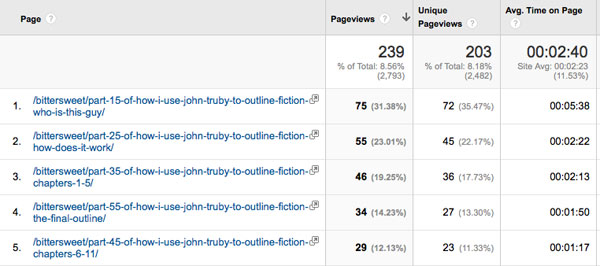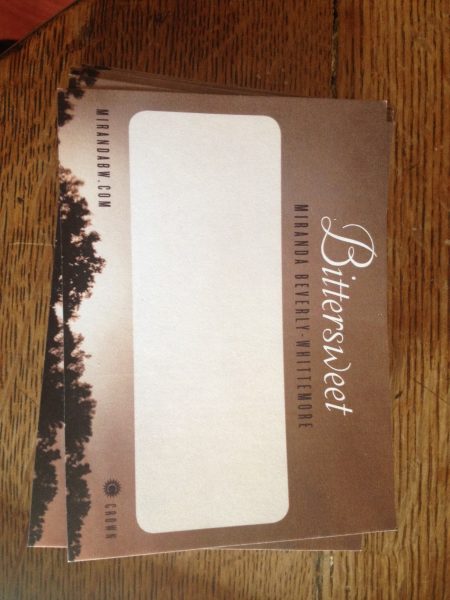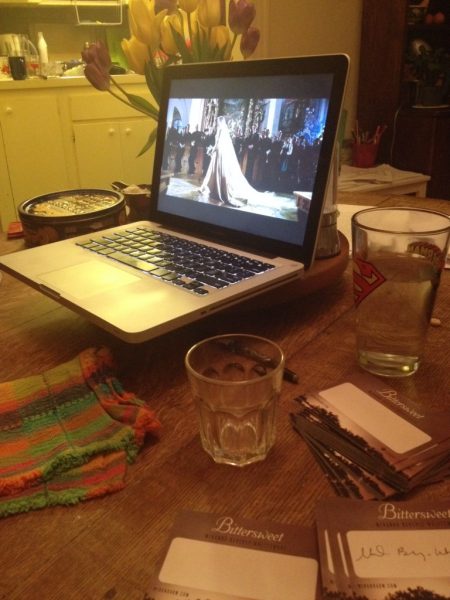This is part of the Bittersweet Book Launch case study, where Dan Blank and Miranda Beverly-Whittemore share the yearlong process of launching her novel. You can view all posts here.
By Miranda Beverly-Whittemore
I’d forgotten how strange it feels to be two months out from publication. I can only liken the experience to sailing toward the home shore at a steady clip, and then, when your destination is in sight, the wind suddenly failing, causing your vessel to become completely becalmed. You know you’re going to get there—you can see home—but it feels as though you never will. It seems as though you’ll just be sitting still, in the middle of a vast body of water, for the rest of your life.
Over the last couple of weeks I’ve felt becalmed. And feeling becalmed, to me, who promised to do everything I possibly could to get the word out about Bittersweet, has been incredibly uncomfortable. Plenty of good is happening for my book, and I have an amazing team at Crown who is steadily and surely getting the good word out, but I’ve never done well with my own idle hands.
And so, a couple weeks ago, when I was texting with my new (and already very good) friend Julia Fierro (whose absorbing novel, Cutting Teeth, comes out the same day as mine, which cements a close bond), and I suggested we might consider putting together a book giveaway for our two books, and she casually mentioned that she is good friends with “a lot” of people whose books are coming out this spring/summer, but that she had no time to organize a big giveaway, and I realized that I am becalmed and I feel like I’ve got nothing but time at the moment, and that Dan Blank is an expert in all things online and that he would probably enjoy organizing the logistics of a huge book giveaway as much as both Julia and I would loathe it, that maybe I had found myself a way to start to paddle toward shore.
(Also, as Dan recently said, I’ve been consciously trying to have my recent outreach projects feel both fun and generous. This idea seemed perfectly positioned at that crossroads.)
The ideas and details fell into place much more quickly than I could have anticipated:
-Between the two of us, Julia and I came up with a list of 29 friends whose books are pubbing between now and August. We researched their titles and pubdates, and agreed to reach out to them once we had settled more about what the giveaway would entail.
-As predicted, Dan was thrilled. He got all excited about legal language and how we’d handle the workflow, and as my eyes glazed over I thanked the heavens that I had the good sense to work with him this year because oh my goodness never in a million years would I be able to handle that very necessary logistical end of things were I doing this on my own.
-Because these writers are Julia’s or my close friends, we immediately knew we wanted the tone of the giveaway to be playful, or friendly, from the image we’d use, to the name of the giveaway, to how we’d feature each author. When we looked at publisher-run giveaways, we found many of them lacked that “personal” connection, a connection that often increases my interest readerly in a book. We wanted to welcome potential readers of any or all of our books into this friendly group, so they’d feel a part of something. I’ve learned this year that when using social media, one of the best strategies one can employ is to make people feel they are a part of something. Generosity begets generosity.
Once we had these three basic cornerstones in place, we knew we had not just an idea on our hands, but a unique, tangible experience that we could be offering. Definitely a better feeling than being becalmed. More on the process of putting together the book giveaway tomorrow!





 “You can offer them in your e-newsletter. You can tell folks to pre-order the book, and that you’ll send them a signed bookplate to put in it.” She gave me a few other good examples of how we’d use them- and I realized how cool it is that people many more readers can now have access to a signed book than they could the last time I was published.
“You can offer them in your e-newsletter. You can tell folks to pre-order the book, and that you’ll send them a signed bookplate to put in it.” She gave me a few other good examples of how we’d use them- and I realized how cool it is that people many more readers can now have access to a signed book than they could the last time I was published.